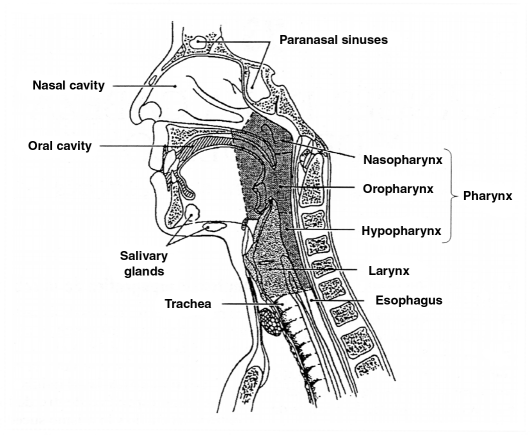What is nasopharyngeal cancer?
Nasopharyngeal cancer is a cancer that starts in the nasopharynx, the upper part of the throat behind the nose and near the base of skull. To understand nasopharyngeal cancer, it helps to know about the structure and function of the nasopharynx.
About the nasopharynx
The nasopharynx is the upper part of the throat (pharynx) that lies behind the nose. It is a box-like chamber about 1½ inches on each edge. It lies just above the soft part of the roof of the mouth (soft palate) and just in back of the nasal passages.

The nasopharynx serves as a passageway for air from the nose to the throat (and eventually to the lungs).
Nasopharyngeal tumors
Several types of tumors can develop in the nasopharynx. Some of these tumors are benign (non-cancerous), but others are malignant (cancerous). It is important to discuss what type of tumor you might have with your doctor.
Benign nasopharyngeal tumors
Benign tumors of the nasopharynx are fairly rare and tend to occur in children and young adults. These tumors do not spread to other parts of the body and are usually not life-threatening. They include tumors or malformations of the vascular (blood-carrying) system, such as angiofibromas and hemangiomas, and benign tumors of minor salivary glands within the nasopharynx.
Treatment of these tumors (if it is needed) is different from that for cancerous nasopharyngeal tumors and is not discussed further in this document. If you have one of these tumors, you and your doctor will talk about what treatments might be appropriate for you.
Nasopharyngeal cancers
These tumors can invade surrounding tissues and spread to other parts of the body.
Nasopharyngeal carcinoma (NPC): This is by far the most common malignant tumor of the nasopharynx. Acarcinoma is a cancer that starts in epithelial cells – the cells lining the internal and external surfaces of the body. Most of the rest of this document refers to NPC.
There are 3 types of NPC, based on how the cancer cells look under the microscope:
-Keratinizing squamous cell carcinoma
-Non-keratinizing differentiated carcinoma
-Undifferentiated carcinoma
Each of these types is seen more often in some areas of the world than in others. In southern China, where NPC is much more common, nearly all cases are the undifferentiated type. In the United States, where NPC is rare, the keratinizing type is seen more often.
Even though these types look different when seen under a microscope, studies have shown they start from the same cell type – the epithelial cells that line the surface of the nasopharynx. The treatment is also usually the same for all types of NPC. The stage of the cancer – how far it has grown and spread – is often more important than its type in predicting a person's outlook (prognosis).
Many NPCs also contain lots of immune system cells, especially lymphocytes. The term lymphoepithelioma is sometimes used to describe an undifferentiated NPC with many lymphocytes among the cancer cells. The presence of these cells does not usually affect the choice of treatment options. But they may be a clue to developing new treatments since they may represent the body's attempt to “reject” the tumor (for more information, see the section “What's new in nasopharyngeal cancer research and treatment?”).
Other cancers in the nasopharynx: Other types of cancers can arise in the nasopharynx.
Lymphomas can sometimes start in the nasopharynx. They are cancers of immune system cells called lymphocytes, which are found throughout the body, including in the nasopharynx. These cancers are discussed in our document,Non-Hodgkin Lymphoma.
Adenocarcinoma and adenoid cystic carcinoma are cancers that can develop in the minor salivary glands in the nasopharynx, but these cancers are more commonly found in the nose (nasal cavity) or mouth (oral cavity). More information on these cancers can be found in our documents, Oral Cavity and Oropharyngeal Cancer, Nasal Cavity and Paranasal Sinuses Cancer, and Salivary Gland Cancer.